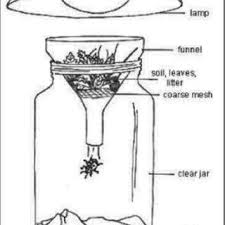Berlese tullgren funnel: Difference between revisions
No edit summary |
No edit summary |
||
| Line 4: | Line 4: | ||
==Composition== | ==Composition== | ||
The funnel is composed of a container, a funnel, a fine mesh lining, a light source and your soil sample. | The funnel is composed of a container, a funnel, a fine mesh lining, a light source and your soil sample. | ||
There are many ways to alternatively make a Berlese Tullgren Funnel as long as the general composition and idea are there. | |||
==Methods== | ==Methods== | ||
==References== | ==References== | ||
<references /> | <references /> | ||
Revision as of 07:46, 30 April 2025
Overview
Berlese-Tullgren Funnels are used to extract arthropods from soil. The funnel works on the basis that arthropods will turn away from direct light, the Berlese-Tullgren funnel works to force them into a container using heat and light. [1]

The funnel was first described by Italian entomologist, Antonio Berlese. He formed the idea by surrounding a metal funnel in a water jacket heated by a bunsen burner. The heat from the water drove the arthropods down the funnel into a collection tube. This was later developed by arachnologist Albert Tullgren who decided to use an electric lamp to heat the surface of the soil. This allowed more time for the insects to reach the collection tube before drying out and dying. [2]
Composition
The funnel is composed of a container, a funnel, a fine mesh lining, a light source and your soil sample. There are many ways to alternatively make a Berlese Tullgren Funnel as long as the general composition and idea are there.
Methods
References
- ↑ “Berlese Funnels - Collecting Methods - Mississippi Entomological Museum Home.” Mississippi Entomological Museum, https://mississippientomologicalmuseum.org.msstate.edu/collecting.preparation.methods/Berlesefunnel.htm. Accessed 30 April 2025.
- ↑ “Entomological classics – The Tullgren (Berlese) Funnel | Don't Forget the Roundabouts.” Don't Forget the Roundabouts, 3 May 2016, https://simonleather.wordpress.com/2016/05/03/entomological-classics-the-tullgren-berlese-funnel/. Accessed 30 April 2025.